Interesting Facts About Woodpeckers
Interesting Facts About Woodpeckers
Woodpeckers are fascinating birds that capture our attention with their unusual behaviours and unique adaptations.
From their relentless drumming to their specialized anatomy, woodpeckers have a repertoire of intriguing qualities that make them truly remarkable creatures.
In this article, we will delve into the world of woodpeckers and explore some fascinating facts about these feathered marvels.
Discover their incredible abilities, remarkable adaptations, and important role in ecosystems worldwide. Get ready to be amazed by the captivating world of woodpeckers!
1. Species Diversity
More than 200 species of woodpeckers make up a diverse group of birds in the Picidae family.
Every woodpecker species' traits, habitats, and activities are distinctively their own.
An illustration would be the Pileated Woodpecker (Dryocopus pileatus), one of the largest species of woodpeckers, distinguished by its bright red crest and loud, resonant drumming sound.
North American mature forests are home to it, creating sizable nest chambers in rotting or dead trees.
On the other hand, the Acorn Woodpecker (Melanerpes formicivorus) is a gregarious species that lives in western North America and is recognized for its granary trees, where it saves acorns and communal breeding practices.
A black head, white underparts, and red hat make up its colourful plumage.
The Great Spotted Woodpecker, also known as Dendrocopos major, is a common sight in Europe and is distinguished by its black and white plumage, red belly patch, and drumming behaviour.
With the help of its strong beak, it forages insects in a variety of wooded settings and makes nesting chambers.
The various species of woodpeckers that can be found worldwide, each with unique adaptations and behaviours, are just a few examples.
Woodpeckers are a diverse group of birds, with numerous species in different parts of the world. Northern Flicker (Colaptes auratus) woodpecker species is found in North America.
It has a unique appearance with a brown body, black bars on its back, and a distinctive white rump patch. It is a typical laughing call and can often be seen foraging for ants on the ground.
Red-headed Woodpecker (Melanerpes erythrocephalus): this striking woodpecker species is native to North America.
It has a bold redhead, black back, and white underparts. Red-headed Woodpeckers are known for their acrobatic flight and ability to catch insects mid-air.
The Black Woodpecker (Dryocopus martius) is found in parts of Europe and Asia; the Black Woodpecker is the largest woodpecker species in the region.
It has predominantly black plumage with a red crest and white wing patches. Black Woodpeckers are known for their powerful drumming and preference for large, old trees.
2. Adapted Skull Structure
The skull structure of woodpeckers has undergone extraordinary evolution, enabling them to withstand the high-impact forces produced during pecking.
Their skulls are specially crafted to shield their brains from damage.
One distinguishing characteristic is their strong and substantial skull bones, which act as a solid defence against the powerful forces generated by their quick pecking.
The hyoid apparatus is a unique feature that belongs to woodpeckers. This apparatus comprises a web of bones, muscles, and cartilage from the tip of their tongues to the back of their skulls.
Dispersing the impact forces away from the brain and acting as a shock absorber lowers the chance of brain damage.
Additionally, woodpeckers have strong neck muscles that help them maintain control and stability during pecking.
The risk of harm is further reduced by the woodpeckers' strong neck muscles, which offer stability and control while pecking.
These adaptations demonstrate how resilient woodpeckers are and how they may engage in their distinctive drilling behaviour without endangering themselves.
3. Pecking Speed
Woodpeckers are remarkable avian creatures known for their incredible pecking speed, capable of reaching astonishing rates of up to 20 times per second.
Their specialized beaks, specifically adapted for drilling into wood, facilitate this unique ability.
With their strong and sharp beaks, woodpeckers can effortlessly penetrate the surface of trees in search of sustenance and to create nesting cavities.
This remarkable pecking speed enables them to efficiently extract insects, larvae, and other small organisms that reside within the wood, serving as a vital food source for these birds.
Furthermore, the drilling prowess of woodpeckers is instrumental in excavating cavities in trees, which serve as safe and secure nesting sites for raising their young.
These cavities also offer protection from predators and harsh weather conditions. Woodpeckers' ability to peck rapidly and precisely is a testament to their exceptional adaptability and resourcefulness in their quest for survival in their woodland habitats.
4. Tongue Length
Woodpeckers' lengthy tongues, essential for removing insects and larvae from the depths of tree fissures, are an amazing adaptation.
They can precisely grab their prey thanks to this gear that enables them to reach deep into tight spaces.
The Northern Flicker, a woodpecker species renowned for its unusually large tongue, is one striking example.
A Northern Flicker can get food sources that are normally unreachable because of a tongue that can stretch up to four inches beyond its beak.
The tongue is not only lengthy, but it also has a special structure that makes it easier to use. It has a barbed or sticky tip that enables woodpeckers to grab insects and larvae efficiently.
The tongue is also extremely flexible and quickly extended and retracted, giving woodpeckers exceptional skill and agility when foraging for food.
This amazing adaption exemplifies the extraordinary evolutionary methods that woodpeckers have created to take advantage of their unique ecological niche as skilled foragers in their wooded surroundings.
5. Acrobatic Climbers
The excellent climbing skills of woodpeckers, made possible by their powerful feet and incisive claws, are well known.
These modifications give them astonishing flexibility and ease with which they can cling to vertical surfaces like tree trunks.
Woodpeckers have powerful muscles and tendons in their feet that give them a firm grip and enable them to hold their place even when pecking ferociously.
The razor-sharp claws improve their climbing ability by adding more contact points with the tree bark.
As a result, woodpeckers may travel in all directions—upward, downward, and sideways—while in pursuit of food.
For finding insects, larvae, and other concealed prey underneath the bark, their capacity to move across vertical surfaces with such skill and control is crucial.
Additionally, woodpeckers can investigate various parts of the tree thanks to their acrobatic climbing abilities, ensuring a thorough search for food supplies.
Woodpeckers exhibit extraordinary adaptability in their foraging behaviour by using their powerful feet and razor-sharp claws.
They also best represent their specialization as arboreal birds capable of expertly navigating their forest surroundings.
6. Anatomy And Adaptations
Woodpeckers have a variety of anatomical traits that help them to succeed in drilling and tree-climbing habits.
Their powerful, chisel-like beaks, created for removing tree bark and wood, are one of their most amazing adaptations.
Woodpeckers may repeatedly peck it without harm because the nib is made operation. They can pierce the surface of trees thanks to their length and sharpness.
Additionally, woodpeckers have unique tongues that are essential to their foraging.
Their long, flexible tongues, armed with barbs or sticky saliva, let them reach far into crevices and retrieve insects and larvae.
Some woodpeckers have tongues that wrap over their skulls, adding extra support while drilling.
Woodpeckers have developed a unique collection of structures to shield their brains from the damage of constant pecking.
Their skulls also feature strengthened designs and spongy bone tissue.
Together, these modifications enable woodpeckers to be expert tree climbers and skilled diggers.
They can build nest chambers, obtain concealed food sources, and communicate through drumming sounds thanks to their strong beaks, unique tongues, shock-absorbing skulls, and climbing skills.
These amazing adaptations have made woodpeckers intriguing to study and have helped them thrive in various settings.
7. Drumming And Communication
Woodpeckers frequently engage in drumming, which has a variety of functions in their communication repertoire.
To mark their territory, attract mates, and communicate with other woodpeckers nearby, woodpeckers utilize drumming as a form of communication.
The drumming sound is produced by swiftly and repeatedly pecking on a resonant surface, such as a hollow tree trunk or a metal object.
Each woodpecker species has a distinctive drumming rhythm that enables individuals to distinguish and recognize one another.
The main purpose of territorial drumming is to establish and protect a territory.
Woodpeckers can produce loud, recognizable noises that travel great distances by drumming on resonant surfaces. By doing so, they can show their presence and control a certain space.
During the breeding season, drumming is essential for luring potential partners. Male woodpeckers frequently perform elaborate drumming to display their prowess and attract females.
Females may use the drumming patterns, which can vary in strength, rhythm, and duration, to judge the quality of potential mates.
8. Feeding Habits
Woodpeckers consume various foods, although their main food sources include insects, tree sap, fruits, and nuts.
They can reach these food sources in multiple ways according to their foraging strategies and unique adaptations.
Insects are a significant part of a woodpecker's diet. They can catch insects lurking in cracks and beneath tree bark thanks to their long, sticky tongues stretching far beyond their beaks.
Woodpeckers drill into the wood with their pointed beaks to reveal insects like beetles, ants, and larvae.
Some woodpecker species, such as the Northern Flicker, are known to hunt for ants and beetles on the ground.
Their long tongues are supported by a specific adaptation known as a hyoid apparatus, which comprises specialized bones and muscles.
Woodpeckers make holes in trees by tapping on them with their beaks; the sap then leaks out. The liquid is then sucked up with their tongues, giving them a valuable energy source.
They might see insects on tree trunks or hear the noises of insects scurrying around in the wood.
When they locate possible food supplies, they use their sharp beaks to drill holes and hollow out areas of the wood to remove insects or sap.
Woodpeckers have stiff tails and powerful neck muscles for stability and support while foraging.
They lean against the tree trunk, keeping their balance and leverage with the help of their feet and tail feathers while they peck and drill into the wood.
9. Nesting And Reproduction
Interesting nesting habits are displayed by woodpeckers, who frequently create their tree cavities for protection and reproduction.
The woodpeckers meticulously carve these cavities with their strong beaks to use as safe nesting locations.
Usually, the male woodpecker excavates by boring a hole in a suitable branch or tree trunk. The female then examines this hole, and she might help it grow and become more refined.
After constructing the nest hole, woodpeckers perform intricate courtship rituals to entice a spouse.
These performances include various actions, including vocalizations, wing-flapping, and pounding on resonant surfaces.
As part of territorial defence, the male may also drum on trees to announce his presence and scare away possible rivals.
Following courtship, the female lays eggs inside the nest cavity, typically one egg each day until the clutch is full.
Depending on the species, woodpeckers can lay between two and eight eggs. Both parents take turns keeping the eggs warm and safe while the other is incubating the eggs.
Depending on the species, incubation times might last between 10 and 20 days.
The parents alternately leave the nest during this time to go food hunting and then return to feed their mate, who is laying eggs and developing embryos.
The parents cooperate to provide the chicks after the eggs hatch. The parents of the young woodpeckers feed them insects, food that is regurgitated, and finally, solid foods as they grow quickly.
Young birds gradually leave the nest to fend for themselves as they become stronger and develop, starting to investigate the area around the nest hole.
10. Unique Tail Feathers
To climb and peck, woodpeckers need to use their distinctive tail feathers. Their acrobatic actions require great stability and support, which these feathers' exceptional stiffness and rigidity help them achieve.
The tail feathers of woodpeckers serve as a support to help them balance and hold their position as they cling to vertical objects.
Woodpeckers can anchor themselves firmly even while using their beaks to apply considerable power because of the rigidity of their tail feathers.
When executing quick, forceful pecks to pierce wood or seize prey, steadiness is especially crucial.
Additionally, acting as shock absorbers, the tail feathers help the woodpecker's body avoid undue stress from each peck by absorbing some of its impacts.
The distinctive tail feathers help the woodpecker avoid potential harm to its fragile neck and head areas by absorbing and spreading the force produced by its drilling action.
This adaptation shows off the amazing evolutionary design of woodpeckers by enabling them to perform their pecking duties with accuracy, efficiency, and little risk of harm.
11. Interactions With Humans
The interaction between woodpeckers and people is complicated and has good and bad features.
Trees and structures may occasionally sustain damage due to their drilling operations, which are used to locate food and make nest holes.
Some people may find the constant drumming and drilling noises irritating.
Several techniques have been used to reduce woodpecker damage, including placing deterrents like reflective tape, netting, or noisemakers or offering alternatives to nesting locations like woodpecker boxes.
Despite the occasional difficulties they might present, woodpeckers play an important role in mythology and folklore worldwide.
In many cultures, they are linked to traits like tenacity, resiliency, and communication. Woodpeckers are frequently portrayed as protectors of the forest or lucky charms.
Due to their unusual look, behaviour, and adaptability, they have been the focus of respect and inspiration in literature, art, and indigenous beliefs.
Woodpeckers are seen as having spiritual powers or as conduits between the human and spiritual worlds in various traditional societies.
Viewing their peculiar drumming and communication patterns as omens or signs is common.
Beyond their physical encounters, these cultural connotations illustrate the enduring bond between people and woodpeckers.
Overall, the relationships between woodpeckers and people involve a complicated mingling of difficulties, awe, and cultural significance.
Fostering peaceful coexistence and appreciation for these amazing birds can be accomplished by being aware of and respecting woodpeckers' natural behaviour.
Overall, there is a complex fusion of difficulties, enjoyment, and cultural significance in the interactions between woodpeckers and people.
Promoting peaceful coexistence and appreciation for these wonderful birds is possible by being aware of and respecting woodpeckers' natural behaviour.
12 Interesting Woodpecker Species
I love woodpeckers. Yesterday, I was holding a young Hairy woodpecker in my hands. Despite the bird protection, the fledgling must have flown into one of our windows and seemed numb.
I sat on the wooden deck, picked him up gently and as soon as I cradled him tenderly, he revived and fluttered to my leg, holding onto it.
I had a minute to admire his beautiful feathers fully. They were black with white spots and some red on his face band/or body. He was about 3″ long. After a few minutes, he flew off, happy to be alive.
Did You Know That:
- There are 198 species of woodpeckers in the world.
- Thirteen of them are found in Canada.
- Twenty-three of them are native to the US.
- And there are only 3 that breed in the UK!
This article lists 12 interesting woodpecker species—the largest at the beginning and the smallest at the end of this blog post.
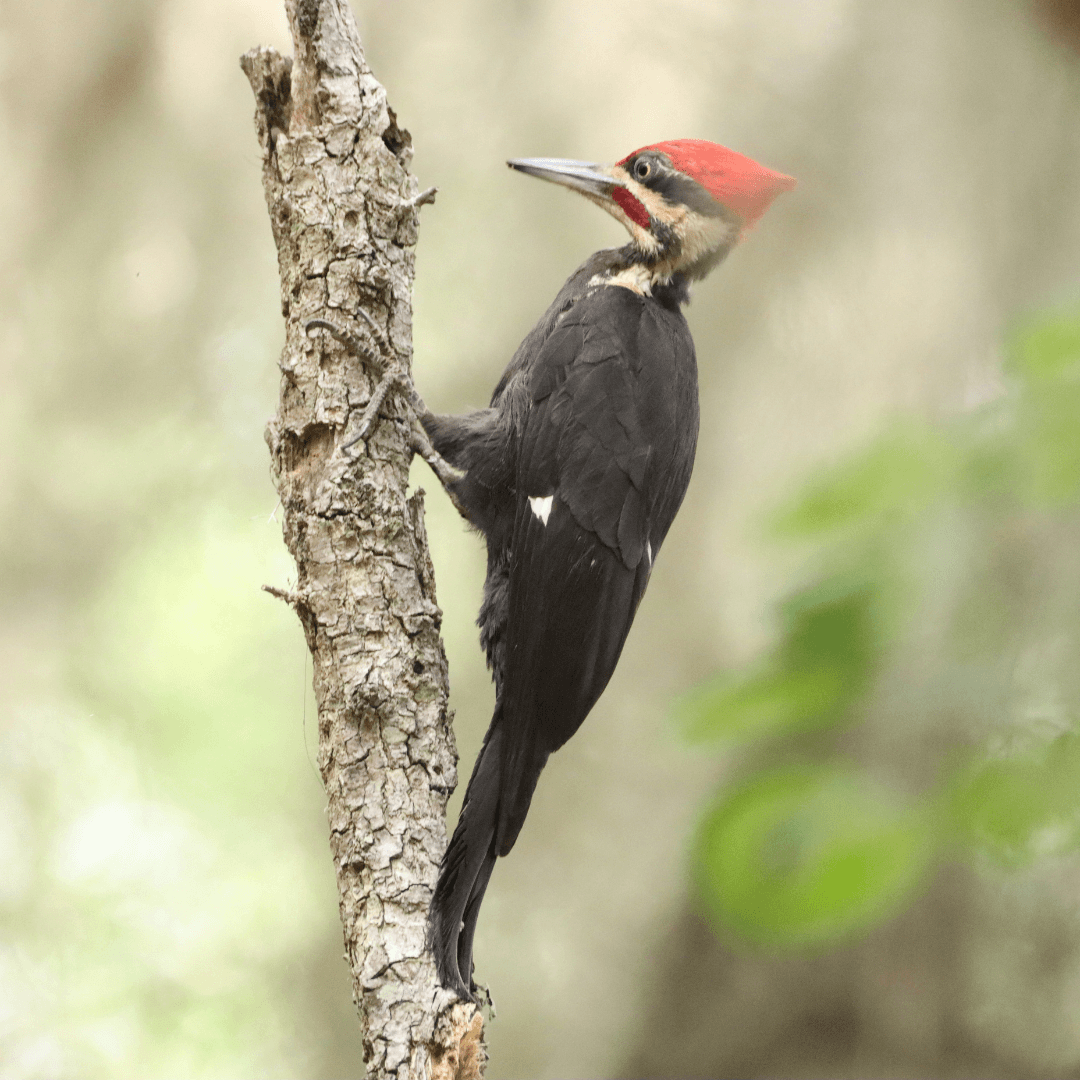
1. Ivory-Billed Woodpecker (Campephilus principalis)
- Description:
- Male: Black, sometimes bluish-black, with white stripes, a bright red crest, light iris, and light-coloured bill. Bill is long and broad and has an ivory colour.
- Female: is slightly smaller and has an all-black crest.
- Weight: 450-570 g
- Size: 48-50 cm (19-20 inches)
- Habitat: South Eastern and South Western United States.
- Notables:
- This woodpecker is the largest species in North America, north of Mexico and the third-largest globally.
- Unfortunately, this beautiful bird is nearly extinct and is now on the endangered list.
- This was caused by an almost complete loss of its habitat. Settlers were cutting down mature forests and using them for farmland and housing projects.
- It is also called the “Lord God Bird.” That's what people say when they see this beautiful bird.
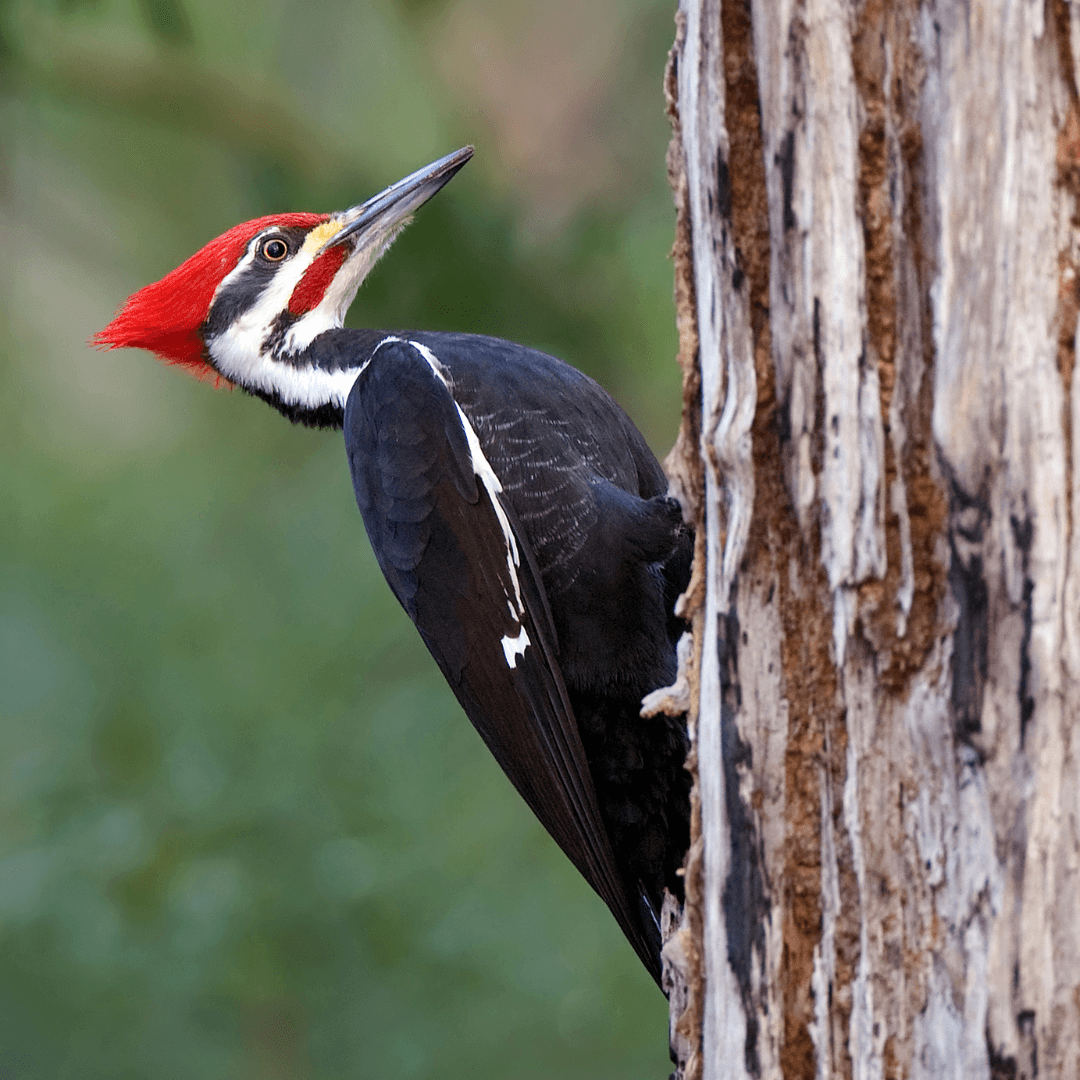
2. Pileated Woodpecker (Drycocopus pileatus)
The pileated woodpecker is one of the largest birds visiting our bird feeders, with the wild turkeys being the largest.
- Description:
- Male: Large black bird with a heavy bill, white stripes, a red crest, and red stripes on his cheek.
- The female has a red crest like the male but doesn't have the red stripes on their cheek.
- Weight: 250-400 g
- Size: 46 cm (18 inches)
- Habitat: Mature forests with large, high trees and scattered large snags.
- Interesting facts:
- The pileated woodpecker may slam its head on a tree 20 times a second or up to 12,000 times daily. And this at a deceleration of 1,200 g. This is huge. Compared to our coughing, we apply approx. 3-4 g.
- This large bird depends on mature forests and dead rotting wood.
- The pileated woodpecker is the 6th largest woodpecker globally.
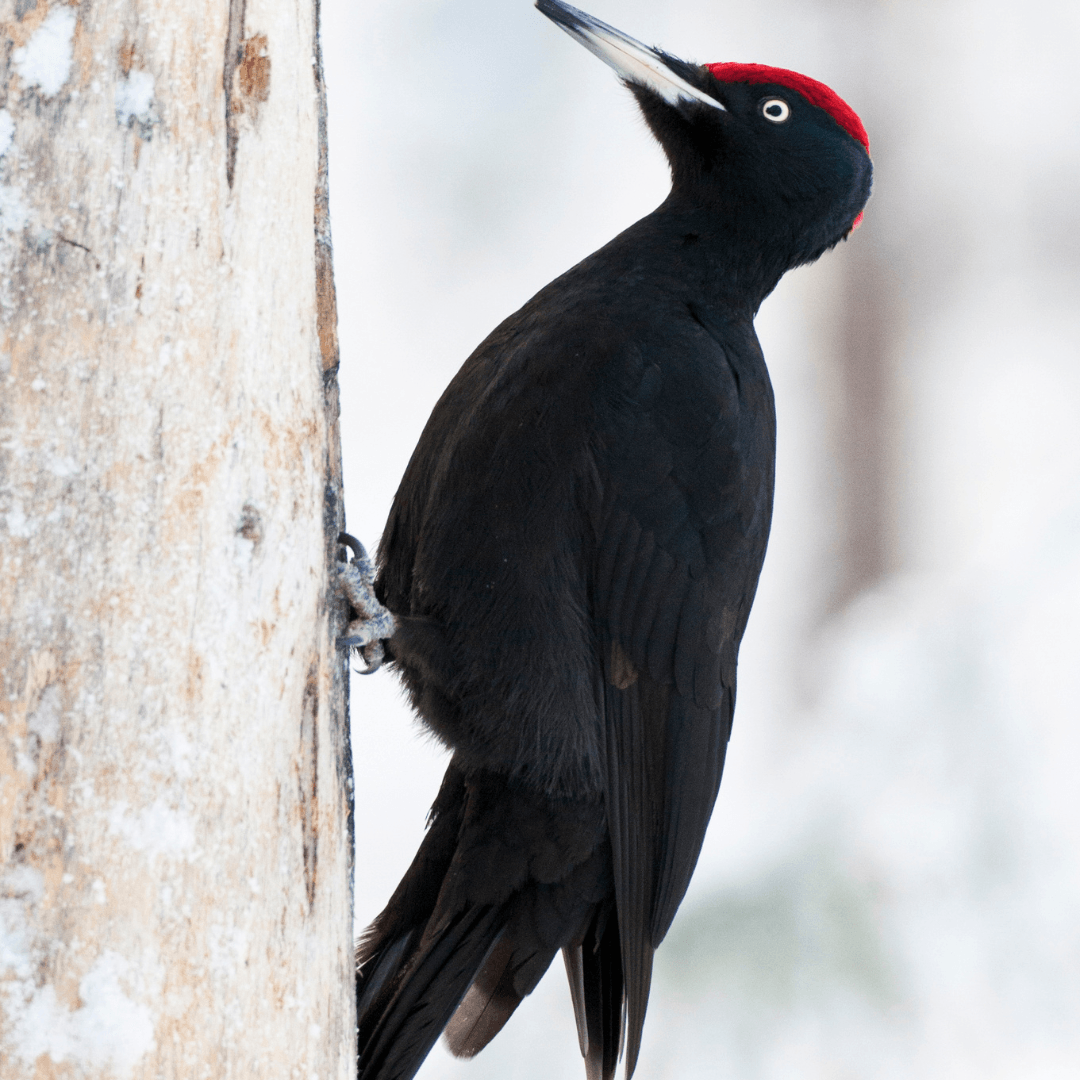
3. Black Woodpecker (Drycocopus Martius)
- Description:
- Male: Entirely black with a red crown.
- Female: She also has a red crown, but only at the back of her head.
- Weight: 320 g
- Size: 45-55 cm (18-22 inches)
- Habitat: Extensive, mature forests in Europe, Asia, and the Middle East
- Cool facts:
- The black woodpecker has piercing yellow eyes.
- It has a manic, high-pitched call.
- Because of these two interesting facts, he was made the villain of fairy tales.
- His flight is different from other woodpeckers. He flies with slow, unsteady-seeming wing beats.
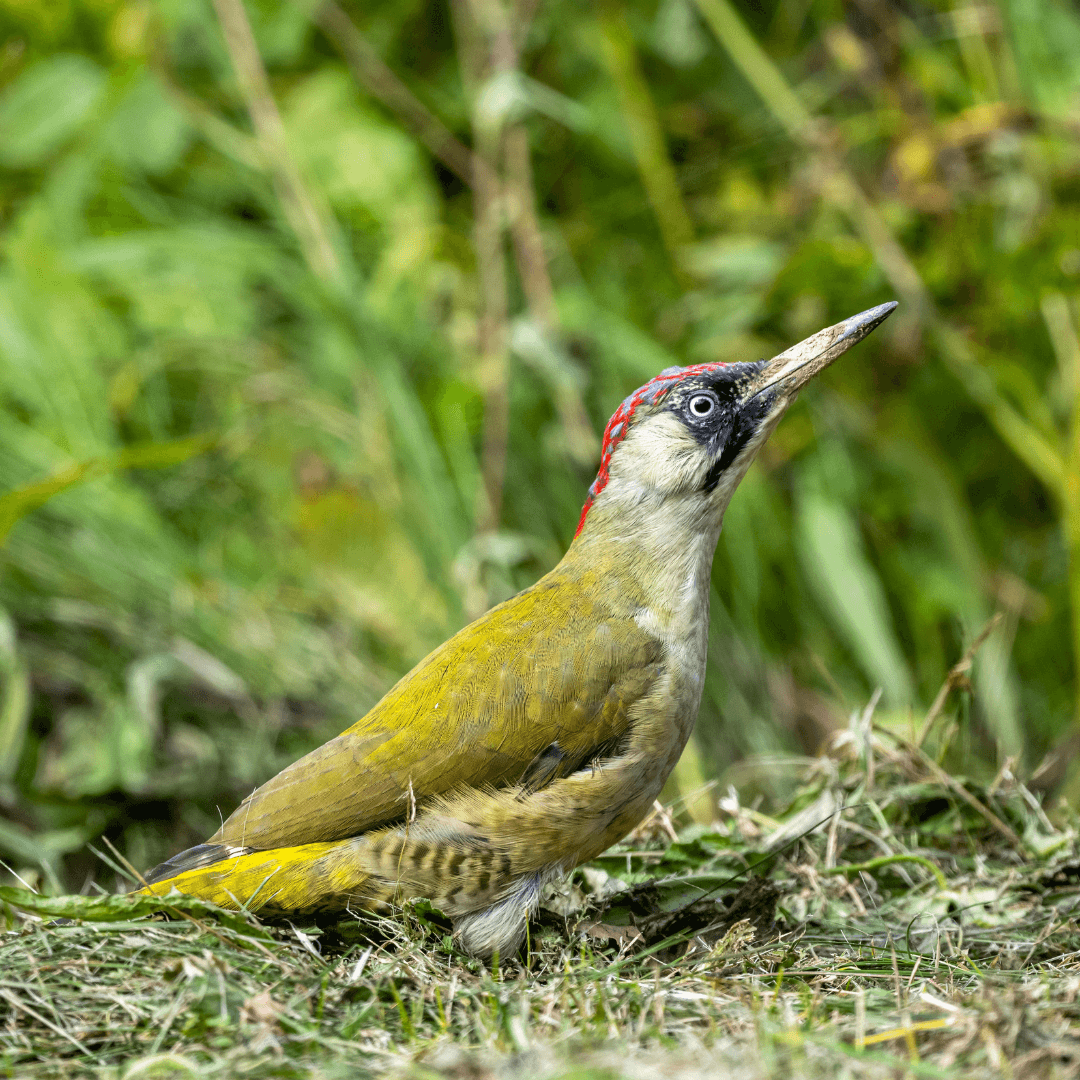
4. European Green Woodpecker (Picus viridis)
- Description:
- Male: Large green woodpecker with a red crown, black mustache, and red stripe in the center.
- Female: The female is the same but has no red line on her mustache.
- Weight: 180 g
- Size: 30-36 cm (12-14 inches)
- Habitat: Widespread in Europe and Asia. Nests in trees and feed on ants that live nearby.
- Fun facts:
- The green woodpecker feeds on ants on the ground.
- This shy bird does not drum on trees like other woodpeckers.
- It can be found through his loud calls.
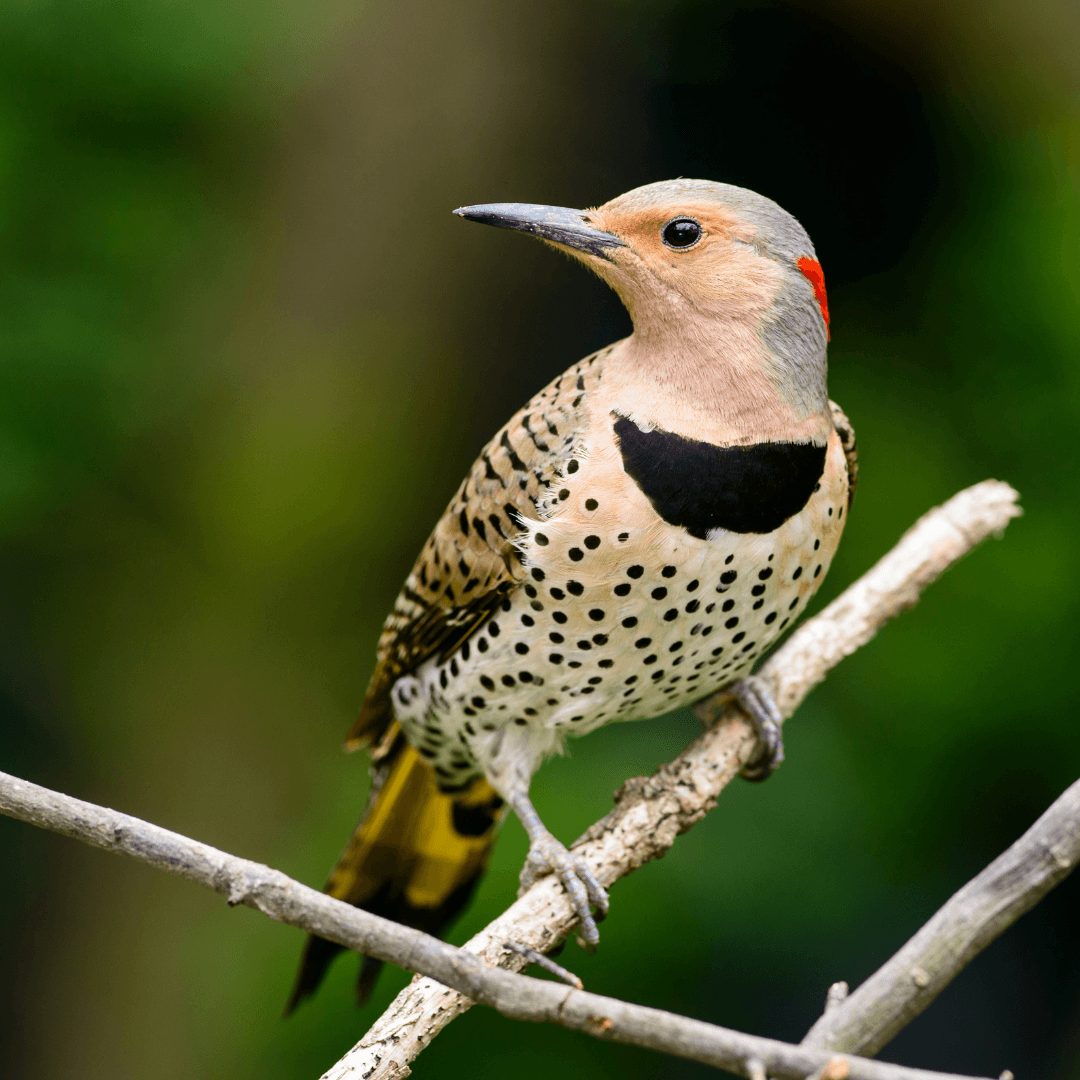
5. Northern Flicker (Colaptes auratus)
- Description: Third largest North American woodpecker (after the Ivory-billed and Pileated)
- Male (yellow-shafted): A very colourful bird with a spotted belly, a black bib, yellow tail feathers, and yellow underneath wings.
- Female (yellow-shafted): The same as the male, but lacks the black mustache.
- The red-shafted male is a mainly brownish-grey bird with red or black whiskers.
- The female red-shafted bird looks the same but lacks the black or red mustache.
- Weight: 120 g
- Size: 28-35 cm (11-14 inches)
- Habitat:
- He occupies many habitats like woodlands, swamps, the edge of forests, and even in the suburbs.
- The yellow-shafted Northern Flicker is found across North America and Canada.
- The red-shafted species is only found in Western Canada and the US.
- Little known facts:
- The Northern Flicker is Alabama's State Bird.
- It is the most common woodpecker in North America. He is nearly as common as the hairy.
- They mainly feed on ants off the ground.
- He is the least woodpecker-like bird.
- They migrate south from the Northern States during the cold winter months.
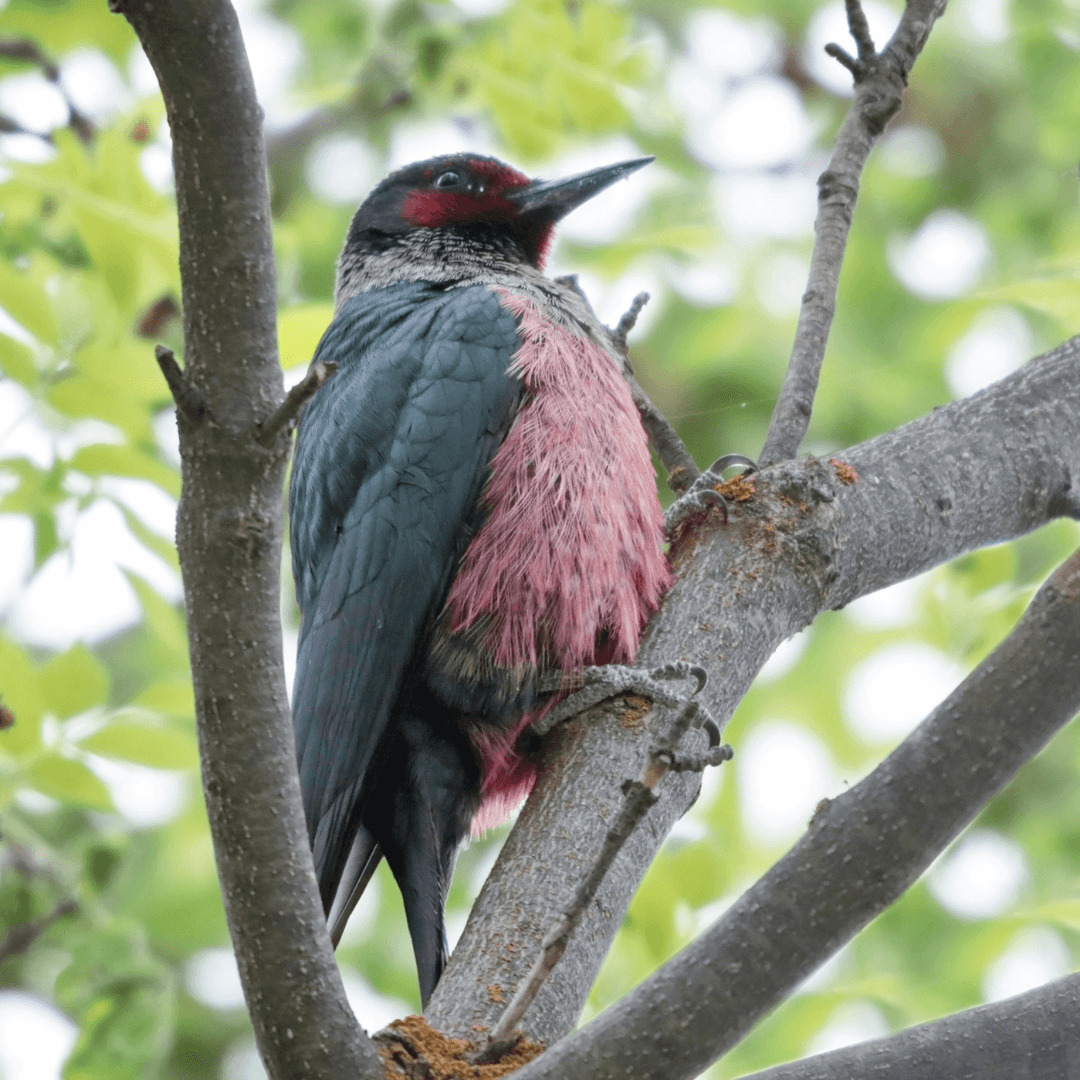
6. Lewis's Woodpecker (Melanerpes lewis)
- Description: A Large green woodpecker with a pink belly, a greyish-white collar, and a dark red face patch
- Males have more red on their faces.
- Females are very similar, maybe a little less red on their faces.
- Weight: 120 g
- Size: 26-28 cm (10″-11″)
- Habitat: The western US and Canada
- Notables:
- The Lewis's woodpecker is very seldom. According to All About Birds, its population declined by 72% between 1971 and 2014. He is on the yellow endangered species list.
- Lewis's woodpecker looks like a woodpecker but behaves like a flycatcher. He sits on a tree and looks for flies, which he then catches in mid-air and eats them.
- Lewis's woodpecker was first described in 1811 by Alexander Wilson and was named after Meriwether Lewis, who first saw the bird in 1805 as per All About Birds.
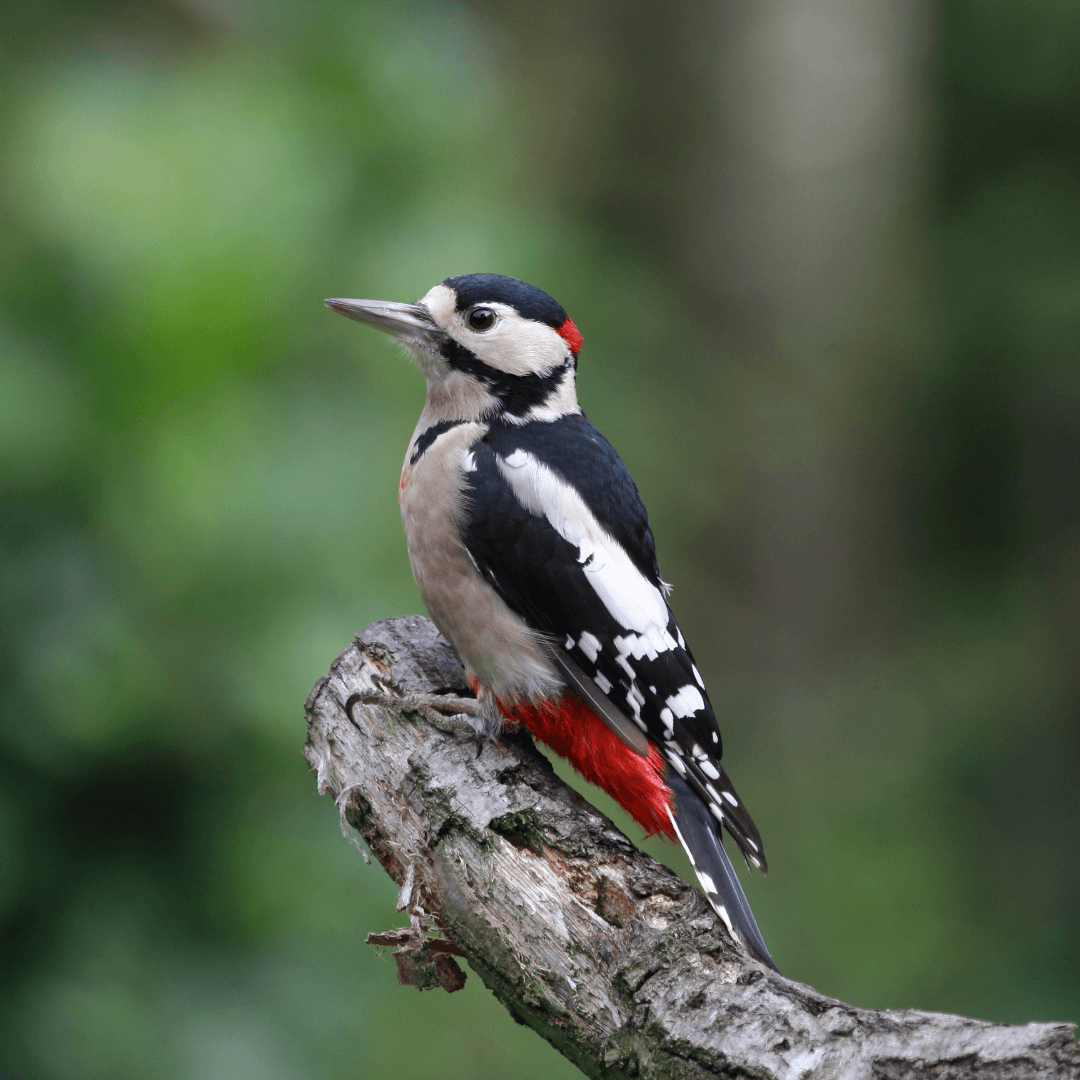
7. Great Spotted Woodpecker (Dendrocopos major)
- Description: The Great Spotted Woodpecker is a medium-sized bird with pied black and white plumage and a red patch on its lower belly.
- Males have red markings on their heads or neck.
- Females are similar to males. However, they have a black nape instead of a red one.
- Weight: 75 g
- Size: 20-24 cm (7.9-9.4 inches)
- Habitat: Northern and Central Europe, Asia and North America
- Interesting facts:
- It is one of the most spread woodpeckers in Europe and part of North America.
- The Great Spotted Woodpecker is an omnivore, which means he eats on insects and seeds and eats eggs or young birds from nests.

8. Red-Bellied Woodpecker (Melanerpes carolinus)
- Description: A medium-sized woodpecker with a pale belly.
- Males have a red crown and nape.
- Females have a red nape and a pale-coloured crown.
- Weight: 72 g
- Size: 23-27 cm (9-10.6 inches)
- Habitat: In forests of the Eastern United States as far as Florida and eastern Canada.
- Cool facts:
- The Red-Bellied Woodpecker mainly eats insects and spiders. It also feeds on plant material, pinecones, acorns, nuts, and berries.
- The oldest Red-Bellied Woodpecker was a male in Georgia. He was at least 12 years and 3 months old.
- This species may sometimes wedge large nuts into crevices and hack them with their beak into manageable pieces.
- Sometimes, it stores food in tree cavities or even wooden fence posts.
- You can even see this bird at backyard feeders in Ontario. It especially loves suet and sunflower seeds and sometimes even drinks from hummingbird feeders.
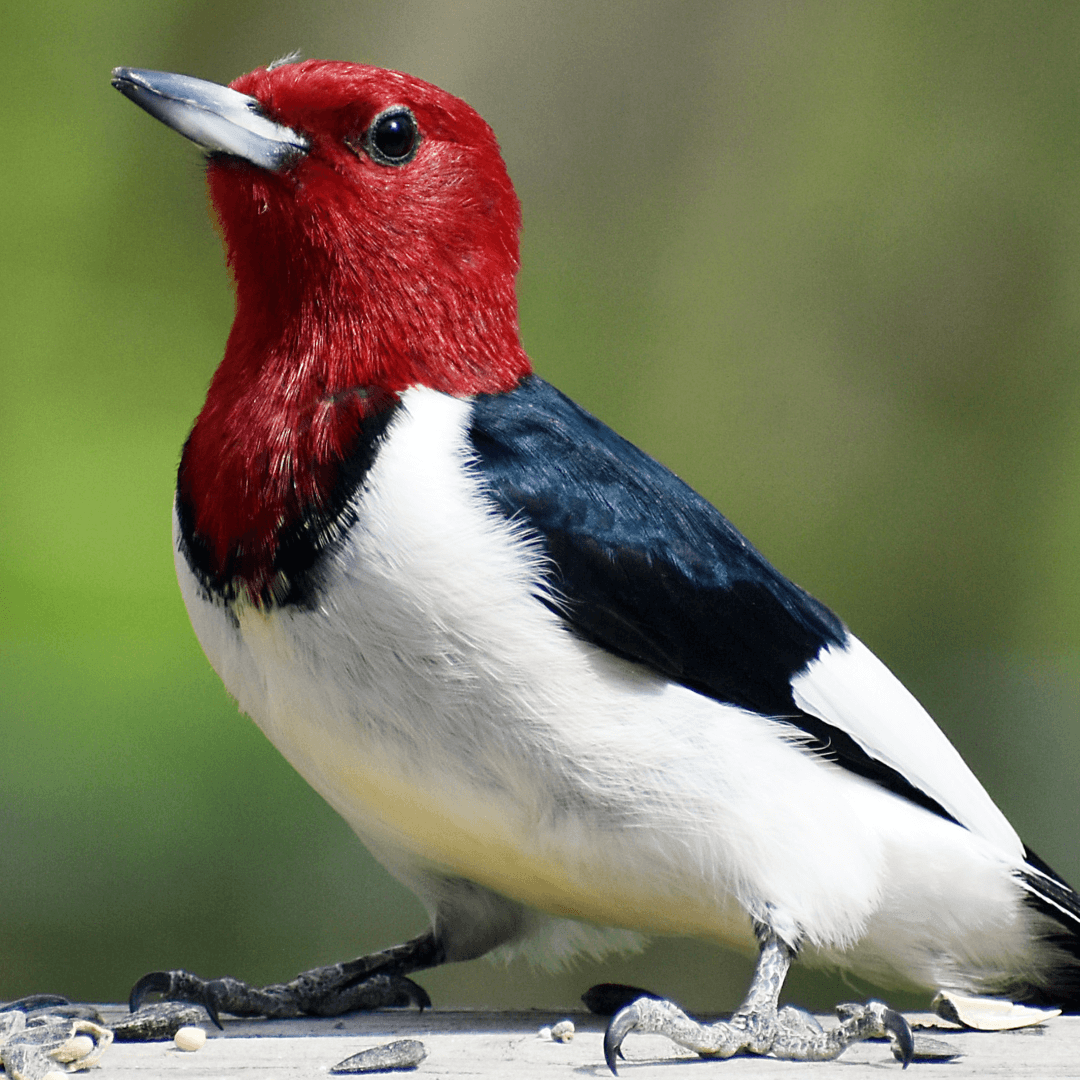
9. Red-Headed Woodpecker (Melanerpes erythrocephalus)
- Description: A medium-sized woodpecker with a large redhead and a chisel-like bill. Its back is black with white wing patches. The belly is pure white.
- Males and Females look alike.
- Weight: 72 g
- Size: 19-25 cm (7.5-9.8 inches)
- Habitat: The Red-headed Woodpecker lives in deciduous forests and can only be found in North America. In Canada, they mainly live in the Southern parts of Manitoba, Ontario, and Quebec).
- Interesting to know:
- The Red-headed Woodpecker population has declined rapidly due to the loss of habitat.
- The 2014 State of The Birds Watch List lists birds that might become threatened or endangered without help from conservation groups.
- This beautiful bird has many nicknames: flying checkerboard, jellycoat, shirt-tail bird, half-a-shirt, and flag bird.
- This species is an omnivore. Its food consists of insects, seeds, and fruit.
- They unearthed fossils of a Red-Headed woodpecker in Florida, Virginia, and Illinois, estimated to be 2 million years old.
- The oldest Red-headed Woodpecker was banded in 1926 and is believed to be almost 10 years old.
- The Red-headed Woodpecker sparked the interest in birds of legendary ornithologist Alexander Wilson in the 1700s.
- The Red-headed Woodpecker is extremely territorial. He is known even to puncture eggs in duck nest boxes.
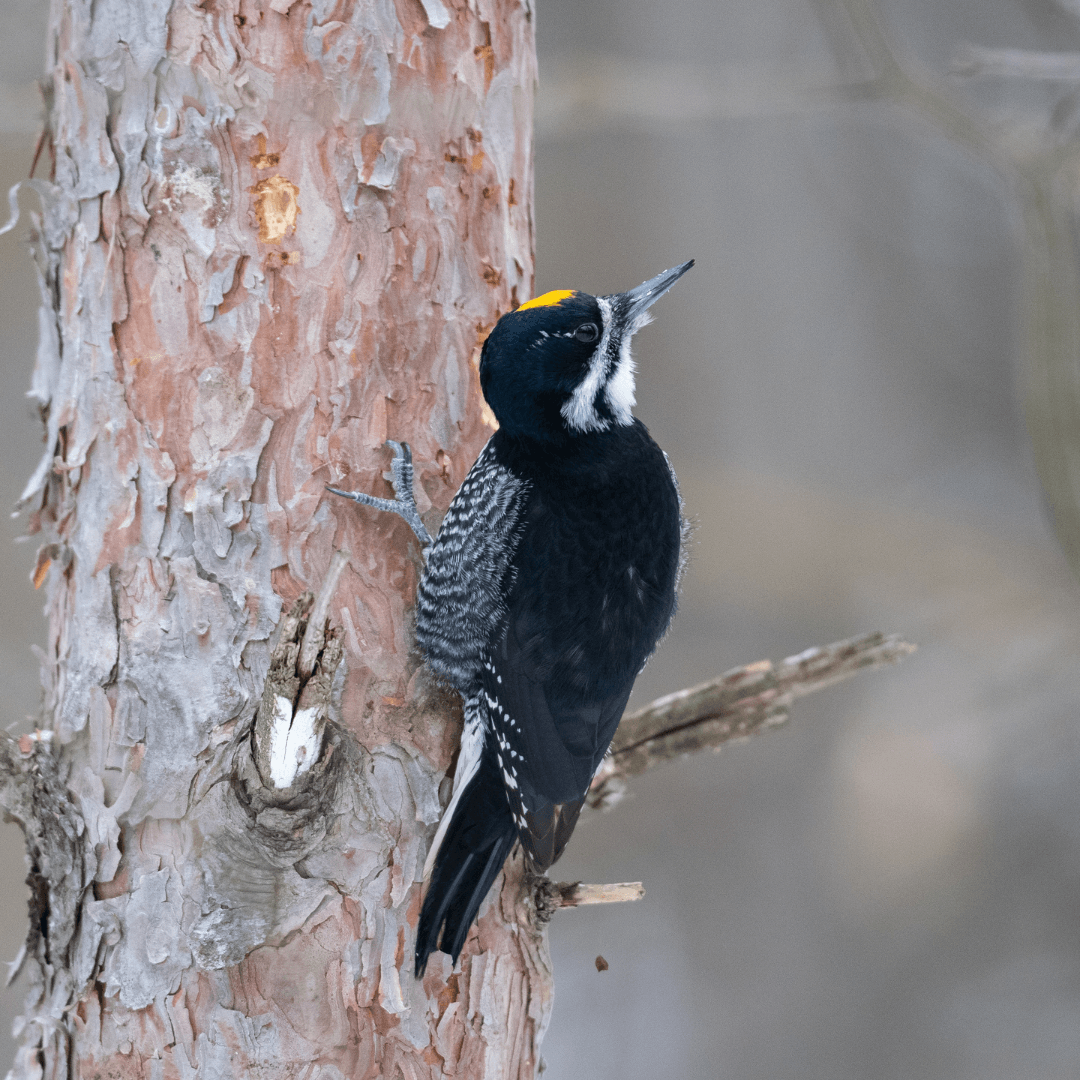
10. Black-Backed Woodpecker (Picoides arcticus)
- Description: Medium woodpecker with a solid black back, a single white stripe on its face, and barred flanks.
- Males have a yellow crown.
- Females look the same as the male but without the yellow crown.
- Weight: 61-88 g
- Size: 20-24 cm (7.8-9.4 inches)
- Habitat:
- Interesting facts:
- This is a rare bird in Ontario.
- The Black-backed, American Three-toed only has 3 toes on each foot.
- All the other woodpeckers have four toes. The suggestion is that the missing fourth toe allows the Black-backed woodpecker to lean further back.
- This way, it can deliver harder blows to trees, possibly helping them excavate nest holes in harder (and therefore safer) wood.
- Black-backed Woodpeckers and many other woodpeckers excavate a new nest hole with each nesting season. This habit creates a ready supply of nesting holes that so-called “secondary cavity nesters can use”—like nuthatches, chickadees, squirrels, bluebirds, and owls. They nest in tree cavities but cannot excavate their own.
- The oldest recorded Black-backed woodpecker was a male at almost 5 years old. It was banded in Idaho.
- During the 1950s and 1960s, the Dutch elm disease killed many elm trees in urban areas in the Northeast.
- Black-backed Woodpeckers moved into the affected cities and towns, much further South of their normal range, to feed on beetles that infested the dying trees.
- In most such areas, the woodpeckers had not been detected or seen since.

11. Hairy Woodpecker (Leuconotopicus villosus)
This is one of the other woodpeckers enjoying our feeders. This summer, I even observed some juveniles.
They were clumsy and constantly called for their close-by parent to feed them. I loved to watch them.
These woodpeckers are quite vocal compared to others, which communicate more with a drumming noise.
- Description: Medium-sized woodpecker with a fairly square head, a chisel-like long bill that is almost as long as its head, black and white overall, with a red spot at the rear of the male's head.
- Male (Rocky Mountains): A red patch at the rear of its head, and its wings are nearly solid black.
- Female (Rocky Mountains): Looks like the male but is missing the red spot on its head.
- Male (Eastern): They have wider facial strips and spotted wings. The male has a red spot on the back of his head.
- Female (Eastern): Same as the male. However, it is missing the red mark.
- Weight: 40-95 g
- Size: 18-26 cm (7.1-10.2 inches)
- Habitat: North America from sea level to high up in the mountains. In Central America, it only lives in the high mountain regions.
- They share their habitat with the Hairy Woodpecker. The Downy uses smaller branches, and the Hairy the trunk of a tree.
- Fun facts:
- I find it rather challenging to distinguish between the Hairy and Downy woodpeckers. They look almost identical to the beginner birder.
- The hairy is the larger one of the two species. It is about the size of a robin.
- It has a very distinguished call, and that's how I recognize it.
- The oldest recorded Hairy was almost 16 years old.
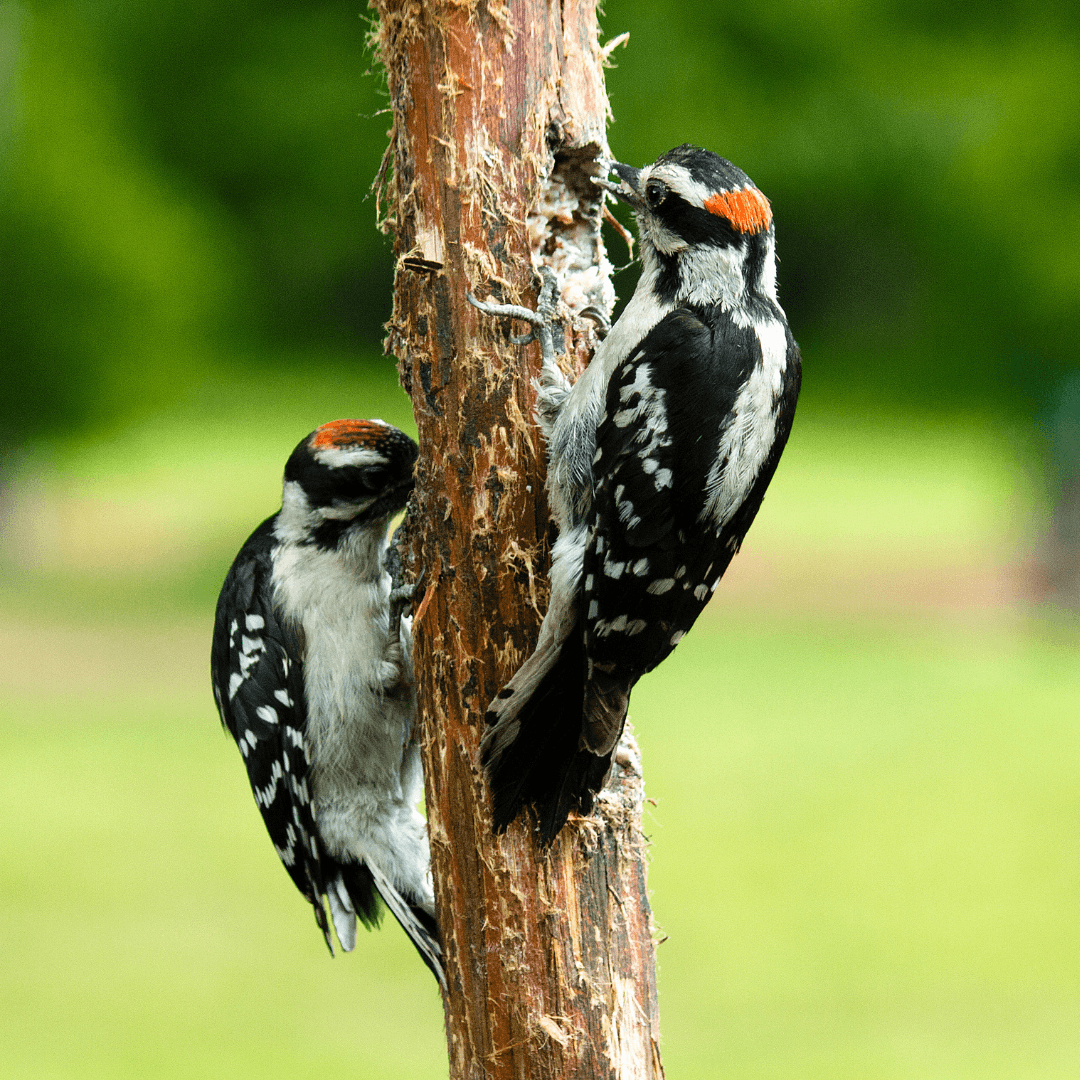
12. Downy Woodpecker (Picoides pubescens)
The Downy is the third woodpecker visiting our feeders.
- Description: Small with a short bill. White (Eastern) or brownish/beige (Pacific) with black back and white spots on the wings. Head striped black and white with a red nape.
- Male: Has a red nape.
- Female: Same as the male. However, she is missing the red spot.
- Weight: 20-23 g
- Size: 14-17 cm (5.5-6.7 inches
- Habitat: North America from sea level to high up in the mountains. In Central America, it is restrained to the mountain regions.
- They share their habitat with the Downy Woodpecker. The Hairy uses the trunks of trees, and the Downy smaller branches.
- Cool facts:
- In the winter, the downy joins other birds like chickadees and nuthatches, which are slightly smaller. The advantage of flocking includes spending less time watching for predators and finding food more easily.
- The downy can be found in parks and suburban areas.
- The Downy is one of the smallest woodpeckers. He is about the same size as a house sparrow.
- Downy woodpeckers have been discovered nesting inside building walls.
- The oldest recorded Downy woodpecker was a male. He was banned in California in 1985 and re-banded in 1996. At that time, he was almost 12 years old.
Conclusion
Woodpeckers are truly remarkable birds with various fascinating traits and behaviours.
Woodpeckers have captured our curiosity and admiration, from their powerful pecking speed and long tongues to their ability to rotate their heads and create resonating drumming sounds.
These birds have adapted to their tree-dwelling lifestyle through specialized anatomy and behaviours, allowing them to thrive in diverse habitats worldwide.
Whether it's their acrobatic flight, acting behaviour, or tool use, woodpeckers continue to surprise and captivate us with their unique adaptations.
Studying and appreciating these incredible birds deepens our understanding of nature and highlights the wonders of avian diversity.
Next time you hear the distinctive drumming or catch a glimpse of a woodpecker in action, take a moment to marvel at their remarkable abilities and their important ecological roles.
I thoroughly enjoyed writing this article. Woodpeckers are very interesting birds, part of several species and subspecies. I especially found the hammering impact on the cranial part amazing.
The pileated woodpecker hammers 20 times at a tree in a second with a deceleration of 1,200 g. Wow, that is a lot of impact.
- Books:
- Peterson Reference Guide to Woodpeckers of North America (Kindle Edition), which talks about woodpeckers in North America and Canada
- RSPB Spotlight Woodpeckers (Kindle Edition) is geared mainly to Great Britain and Europe. They are both very interesting and contain a wealth of information.
- Credits:
- All About Birds, Audobon, The Spruce, Wikipedia, etc.
I trust you enjoyed this article on the Interesting Facts About Woodpeckers. I thoroughly enjoyed researching and writing it. Please stay tuned for more blog posts to come shortly. Take care
JeannetteZ
Your opinion is important to me
Thoughts? Ideas? Questions? I would love to hear from you. Please leave me your questions, experience and remarks about the Interesting Facts About Woodpeckers article in the comments section below. You can also reach me by email at Jeannette@Close-To-Nature.org.
Disclosure
This post may contain affiliate links. I earn from qualifying purchases as an Amazon Associate and other affiliate programs. Please read my full affiliate disclosure.
You might also enjoy these blog posts:
Best Simple Ways To Relieve Stress And Anxiety
Interesting Facts About Squirrels
All About Wild Turkeys – A Large, Shy Bird
Why Is My Dog Stressed And How To Relieve It

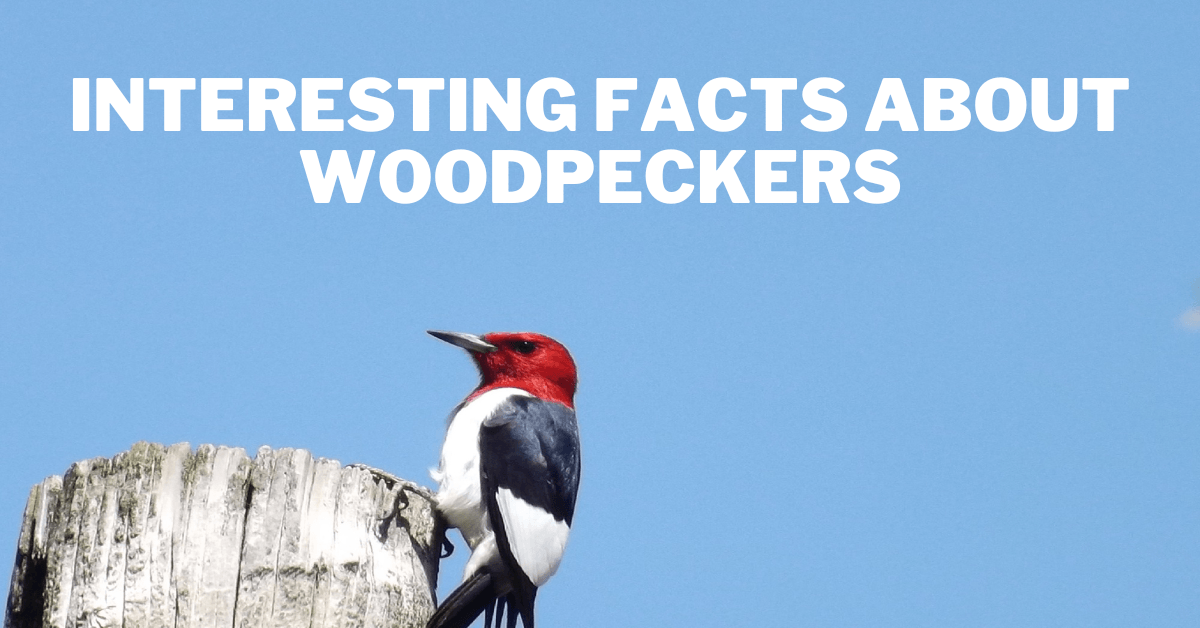



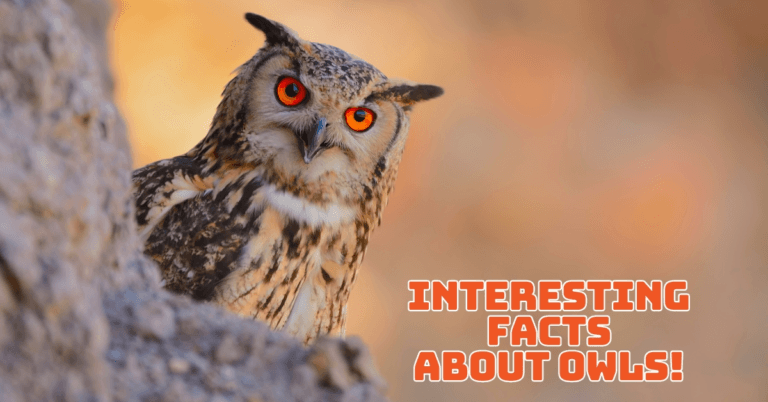

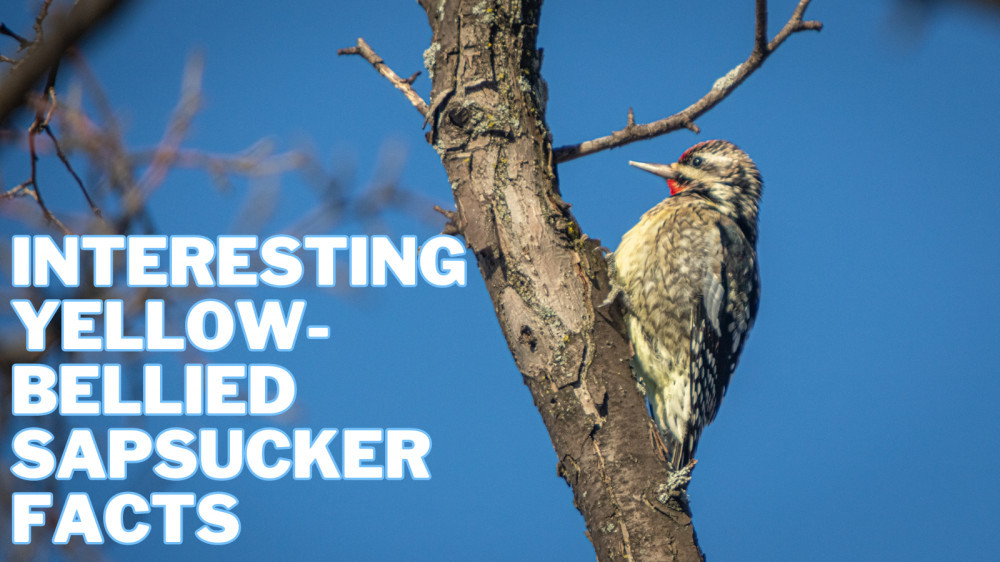
Hello,
Let me first off start by saying that I never knew there were so many different kinds of woodpeckers. Whoa!! Your site is very informational when it comes to how you talked about the different woodpeckers, and how they look, where there habitats are, and their descriptions. Good job. How did you get your love for woodpeckers? Did you grow up learning about them? It’s a very interesting subject. Something that I never thought about honestly. You did a great job placing your pictures within your site to reflect the information of that particular woodpecker. Being able to see what the particular woodpecker looks like while reading about it, makes your content more interesting. Good work on this post!! Keep up the hard work.
Ni
Hi Ni,
Thanks so much for your lovely comments. We live in the middle of nature, and we can watch wildlife from our sunroom window.
A few years ago, we set up a bird feeding station, and that’s where I saw my first woodpecker. When the Pileated Woodpecker visited our suets the first time, I was amazed at its beauty and size. I wanted to know what kind of a bird it is. That’s how I got started with woodpeckers.
Have a lovely day!
Jeannette
I love going on nature walks with my kids and we often hear woodpeckers while we walk. These facts are perfect for sharing with them. My kids are going to love to learn that woodpeckers are “guardians of the forest” and that they are so good for the forest ecosystem.
We often hear the woodpeckers in the forest but can’t always spot them. I’ll have to keep my eye out this spring and summer to see if I can identify what kind of woodpeckers we are hearing. Thanks for the valuable resource!
Thanks, Leah. I know the woodpeckers are not easily discovered. I see them at our bird feeders, but they are hard to detect in the woods. Depending on where you live, there are more or fewer species of woodpeckers. Here at our place (Eastern Canada), we have 3 regulars. The one very distinctive woodpecker call is the Hairy. This gives me an idea. I will add some sound to my blog post. Then you and your kids will recognize them as well.
With gratitude
Jeannette